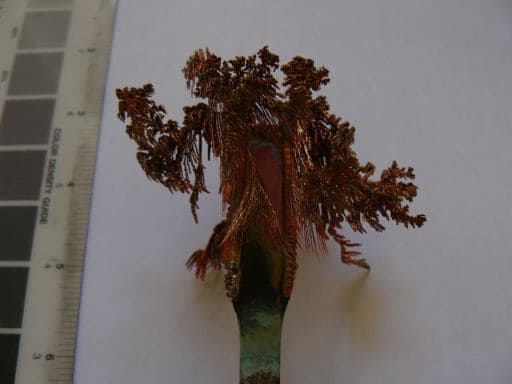
Curated with aloha by
Ted Mooney, P.E. RET

The authoritative public forum
for Metal Finishing 1989-2025

-----
Vegetative Growth in Acid Copper
Hi,
I was hoping to get some advice about an unexpected result from a sample I grew in an acid copper bath. I'm trying to encourage treeing deposits in an acid copper bath, with an eye to making a sculpture employing this phenomenon. I've been trying various combinations of sulfuric acid, copper sulphate, proprietary levelers and brighteners and adjustments in current density to get a range of different aggregations. I've made a number of different samples, using phos. copper sheets cut into strips as anodes, and plating onto a thin strip of the same material over long durations in a small bucket bath with some aquarium air pumps providing agitation. I had one real stand out from the spectrum of deposition behavior I've seen and I think this is because the bath became contaminated. I find the sample very attractive and would like to reproduce the result but I've tried reformulating the bath and have gotten a very different result, probably because of the absence of the contaminant.
Can anyone help me determine what this contaminant might be, or suggest another contaminant that might achieve the effect seen in the sample?
Some information about the 1 gal bath: 18 oz/gal CUSO4, 6 oz/gal H2SO4, 0.6 ml HCl, small concentrations of brightener and leveler. Agitation via air pump. Phos-copper anode. 72 hours of plating at 2V about 1 A. Some curious things that happened over the plating run: solution went from clear blue to an opaque green cast, and was leaving a yellow-ochre scum where it contacted the poly-pro bucket, when the solution was later filtered through coffee filter the sludge was a similar ochre color (unlike the typical copper/brown sludge I've encountered.) In the image of the sample, notice the rainbow iridescent ringing at the central bar. I think this points to an organic contaminant, could this be the Bon Ami
⇦ this on
eBay
or
Amazon [affil links]
I've been using to clean copper with? Any suggestions of a contaminant that might encourage this vegetative-like growth?

Hobbyist - Doylestown, Pennsylvania, USA
June 11, 2008
----
Ed. note-- Readers, who are experiencing a feeling of deja vu may wish to know that John has been working on somewhat similar projects for some time now, and has previously contributed to threads 45277 and 46603.
Was your solution open to air?
Is there any proteins or other things in the solution that would support any plant or bacteria?
I'm thinking either a yeast or algae may be responsible.
Allow me to expound a bit further, I've read recently that the EPA is doing some uranium contamination cleanup work by using bacteria to nibble off electrons from the uranium 7 and get it down to non-reactive uranium 3.
Do you think it would be possible you accidentally did something similar? It would probably be informative to put your sample under a microscope and see if there is any cellular pattern or any other trace of an organism at work. If not it would at least help you trace how this spread out.
Blacksmith - Melbourne, Florida
July 29, 2008
Q, A, or Comment on THIS thread -or- Start a NEW Thread